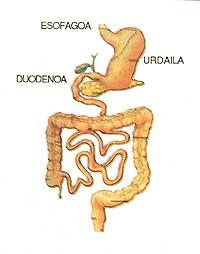Ulcus Ulcus
1989/01/01 Agirre, Jabier - Medikua eta OEEko kidea Iturria: Elhuyar aldizkaria
Today it is known that animals also have ulcers. However, in animals there are few chronic ulcers.
The percentage of ulcers continues to grow day by day. A few years ago I played one in twelve people. Today, women also suffer from understanding, probably because over time their lives have been changing. A few years ago, women's work (doing homework) was frustrating, but it was also a certain form of protection against ulcer. At present, work outside the home has subordinated the woman to the pressure and stress and the anguish and competences in the work are negative factors for anyone who tends to suffer an understanding.
What is the ulcer?
The ulcer is only a small wound, since in the esophagus or esophagus, in the stomach or in the upper part of the intestine, the secreted gastric juices have “lyserized” the tissues or layers of those tissues, causing pain and other annoying symptoms.
For the location, the ulcer can be of three types:
- U. ESOPHAGEAL. It is usually located at the end of the esophagus, near the limit of the stomach.
- U. GASTRIC. It is an ulcer located in the stomach itself.
- U. DUODENAL. It is located at the top of the sausage, near the contact area on the stomach.

The form of the ulcer is usually circular or oval. In depth it can be a light and soft depression, in the form of U, which is located on the deepest walls of the esophagus, stomach or duodenum, and on the other end it can be very deep, like a channel or a channel, which crosses laterally the walls of the digestive tract.
The ulcer may have little importance or become a serious and chronic problem that prevents carrying a normal life.
Some 10-12% of the total population will suffer from peptic ulcer at some point in their lives, without the age producing differences. Approximately 80% of all ulcers are duodenal and almost 20% gastric (located in the stomach). Esophageal ulcers are scarce and according to statistics they are below 1% of the cases.
Ulcers remain more frequent in men than in women (10:1 duodenum ulcers and 3-4:1 stomach ulcers). Almost all ulcers develop mainly in the center of life. However, when children have ulcer, it is usually duodenal, while children over 45 are mainly gastric.
Without taking into account the type of ulcer, the onset and the diseases appear in spring or end of year. Duodenal ulcers are usually resolved between 80% and 90%. Only 10% survive all treatments or develop complications. However, it is important for the patient to follow at all times the advice given to him by his doctor.
Why does the ulcer arise?
Some of the causes that cause ulcer may be controlled, but others may not. There are many factors involved in the formation of ulcer.
Stress stress stress stress
One of these factors seems to be. Also age (maturity, above all), sex (with higher propensity between puberty and older than men), type O blood and the impossibility of secreting certain substances in saliva. Other factors are situations that cause excess secretion of gastric acid in the stomach (often due to unknown causes). Also glandular or hereditary factors.
As an opposite factor, drinks containing alcohol, tobacco, tea, coffee, or cola may be cited, which stimulate the secretion of gastric acids (as with some medications). Aspirin, any anti-inflammatory analgesic, or cortisone, if given at high doses for long periods of time, is another negative charge for the treatment of ulcer.
As can be seen in this list, we have no influence on many factors that facilitate the appearance of the ulcer. However, the patient should try to maintain a healthy life. Give up certain foods, foods and medications (they are already known to produce adverse effects) and especially rule out excessive stress.
More than one will seem surprising that emotional and physical stress affects the ulcer. However, emotions have a fairly demonstrated influence on the functions of the body. Just as our face worsens in the skin because blood flow increases, when something disturbs us or when we get angry we breathe faster, the stomach also responds to these sensations. When someone feels sad, angry, hurt, neglected by others or treated unfairly, their stomach flows more acidic and their ulcer gets worse.
What to do when you understand it?
First follow your “regime”. The doctor will have already provided (or otherwise) the instructions and advice that best suit your particular case. Follow always and especially when symptoms of ulcer appear. Without your help and collaboration, neither the doctor nor the medication can cure the ulcer.
As for rest, keep in mind that people who habitually have an understanding are fully working, of great responsibility, but who worry too much. Many times they do more than they have to do.
People with ulcer are not very tidy in the meal: they eat very little or no time (for lack of appetite or stomach aches). The tear of food facilitates that the gastric acids act directly on the ulcer, since they do not contain any food for digestion. Therefore, in the anti-ulceration regime it is recommended to eat a lot, as long as there are fixed hours of light food. Discard rare combinations of food. Food weights, strong foods, excessively hot or cold foods and excessive species should normally be ruled out.
On the other hand, it is convenient to avoid, if possible, the serious or distressing situations mentioned above. When this is not possible, try not to worry too much.
As for the medication, it is advisable to take the antiacid prescribed by the doctor in the dose and in the prescribed hours. Antacids alone will not cure the ulcer, but within a larger program (size of food, more relaxed life, etc.) its place and its function.
If possible, the ulcerative patient should try to rule out social actions or accept only the quietest ones. It is advisable to exercise regularly with the doctor's consent, but always discarding the most demanding and competitive sports.
Below is the appropriate feeding measure for the itinerant ulcerated patient (extracted from the LISERIKETA dictionary, prepared by Patxi Letamendi).


Gai honi buruzko eduki gehiago
Elhuyarrek garatutako teknologia




